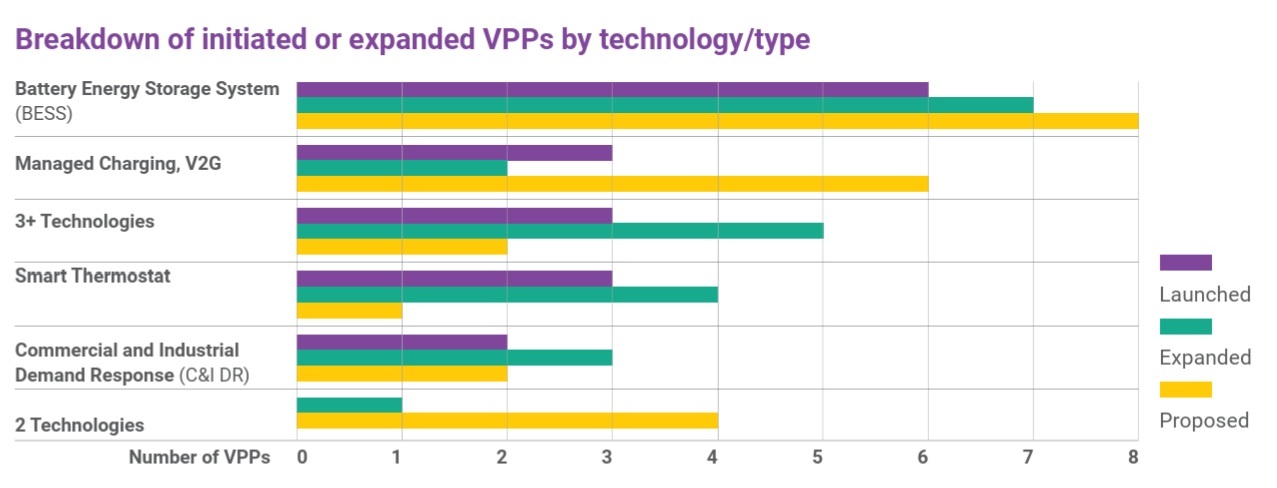RMI’s virtual power plant coalition (VP3) released a progress report that indicates that state legislators, regulators and utilities initiated, advanced or expanded policy in support of virtual power plants.
Virtual power plants (VPPs) are an aggregation of small-scale distributed energy resources including solar energy systems, electric vehicles (EVs), EV chargers and demand response devices including water heaters, thermostats and appliances.
RMI (formerly Rocky Mountain Institute), a non-profit aiming to improve energy practices in the U.S., developed the Virtual Power Plant Partnership or VP3, a coalition of nonprofit and industry voices intending to change policies, regulations and market rules to unlock and scale VPPs. The coalition has members that span the automotive, building, energy service, software, and other sectors, VP3 reports.
VP3 is working toward a future where businesses, households and communities are empowered through VPPs, which can help to support cost-effective energy, emissions reductions, and a more resilient electricity grid. Initial funding of the VP3 effort came from General Motors and Google Nest.
In a recently released progress report, the VP3 coalition states that if 2023 was the year of awareness about VPPs, 2024 was the year of action.
In 2024, ten state legislatures introduced VPP bills, regulators in ten states and Washington, D.C., advanced VPP policy, and utilities in 34 states and Puerto Rico initiated or expanded VPPs.
Four examples include:
- In Colorado, the Public Utilities Commission issued its final report on implementing third-party VPPs.
- In Massachusetts utilities will implement a $50 million Grid Services Compensation Fund to promote non-wires alternatives by compensating dispatchable distributed energy resources and flexible loads that participate in utility dispatch to provide services.
- New Jersey utilities, PSE&G, O&R, and ACE, received approval for Triennium II Plans and will launch a residential smart thermostat distributed resource program. PSE&G will also launch a battery VPP.
- The Washington, D.C. Public Service Commission finalized a request for proposals (RFP) for a distributed energy resource management system (DERMS) project to be released in 2025. The RFP will fund a VPP or pilot that will operate for at least two years with the intent of being extended after the pilot ends.
VP3 also noted increased regulator interest, as the coalition provided input and feedback to regulators and utilities in several states. In addition, utilities in 34 states and Puerto Rico took what VP3 called “meaningful action” to initiate or expand VPPs.

Beyond policy and utility action, the VP3 members made formed partnerships that advance the industry.
For example, Solrite Energy, a solar and storage financier, and sonnen, a VPP and battery storage company, announced the launch of a VPP power purchase agreement (VPA) in Texas. Under the VPA, Solrite will install panels and Sonnen Core+20 batteries at eligible households with no upfront costs to customers. The batteries, which will provide up to 60 kWh of capacity, will link into a VPP managed by Sonnen. Enrolled homeowners will pay 12¢ per kWh, compared to the 19¢ to 20¢ per kWh rate common in Texas, for the energy their systems produce.
Targets set
VP3 set long-term targets for the industry. By 2030 the target is to have market conditions that will allow VPPs to provide 160 GW of peak-coincident capacity. By 2035, the target is for all U.S. electricity consumers have access to VPP programs.
This year VP3 is focusing on seven 12-month objectives:
- Center VPPs as a reliability solution
- Support utilities to design and implement VPPs
- Enable New York to become a lighthouse state for VPPs
- Empower Michigan to become a regional VPP leader
- Act as an industry voice to support standardization of VPP operations
- Locate VPPs in the national energy transition conversation
- Align on a strategic vision for market advancement
(Also read: What are states doing to make virtual power plants a reality?)


